Get EOS

Where to Store EOS
Once you’ve acquired EOS from one of the platforms above, you’ll need a safe and secure location to store it. Head over to the Pick a Wallet page to learn more about the wide rang of tools that are available for token holders to take advantage of for this use case.

Bridge to EOS EVM
In order to move EOS tokens from EOS Native to the EOS EVM, you’ll first need to hold them in your EOS Native account. Then you can use the trustless bridge to move the tokens to EOS EVM and back again.







